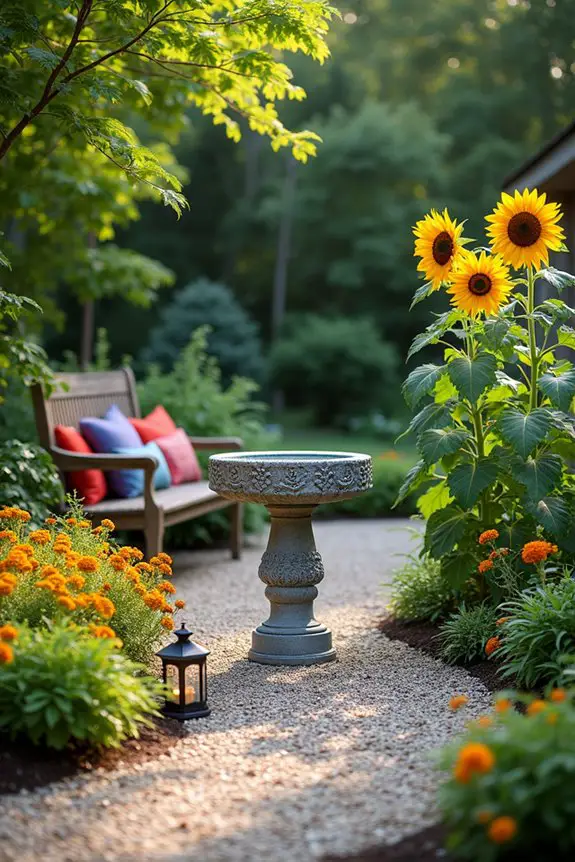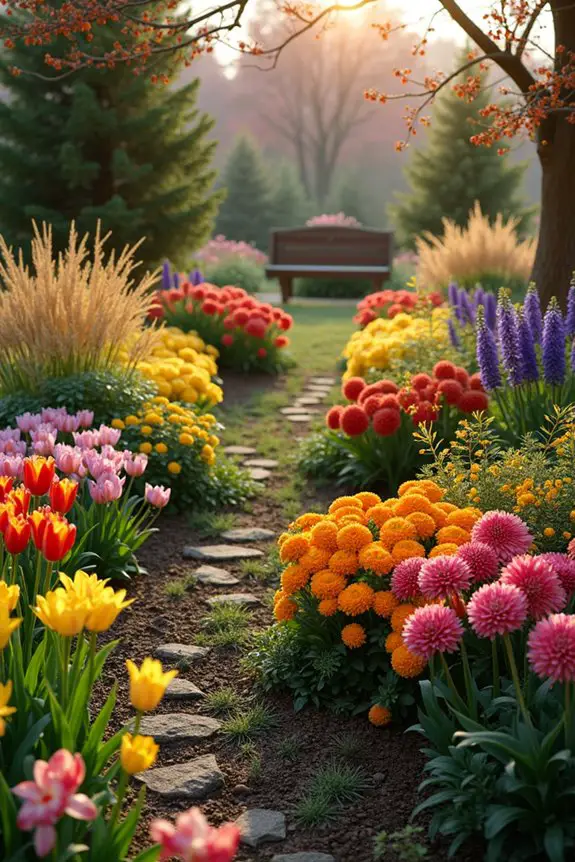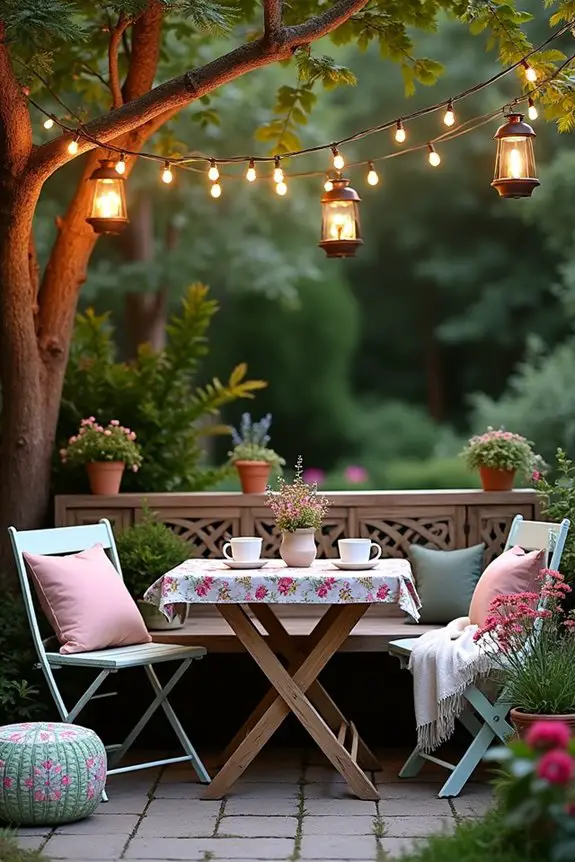Have you ever stood in your backyard, dreaming of a magical space that feels like a cozy retreat? You’re not alone. A well-designed garden layout can transform even the smallest patch of dirt into a serene getaway. Picture winding paths, colorful blooms, and maybe a charming sculpture or two. Sounds nice, right? Stick around, and we’ll explore ten design ideas that might just spark your creativity—and perhaps inspire you to grab a shovel and get digging.
The Layouts of Serenity
When you think about creating a peaceful retreat, have you considered how garden layouts can really set the mood?
Imagine winding pathways that lead to colorful flower beds and a gentle water feature—you’ll feel tranquility washing over you.
With smart plant choices and vertical structures, you can turn any outdoor space into your personal sanctuary, making it a treat for both your eyes and your soul.
1. Zen-Inspired Garden Pathways
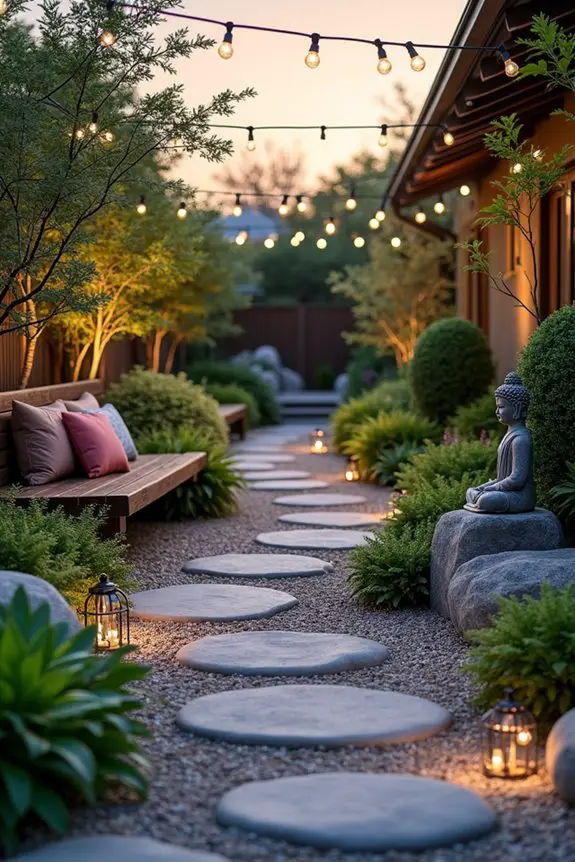
Creating a Zen-inspired garden pathway isn’t just about having a clear route through your plants — it’s about crafting a serene experience. Think of it as the main ingredient in a recipe for relaxation, where every step you take invites peace and mindfulness. A well-designed pathway can guide your journey and help the heart feel lighter, just like that first sip of a well-brewed cup of tea.
So, let’s explore some ideas! First up, consider using natural materials. Think gravel, stepping stones, or even bamboo—yes, bamboo! It’s like the VIP of garden pathways. Not only does it look chic but it also blends beautifully into the natural surroundings. You’ll achieve that earthy vibe while making sure no one trips over their own shoes. You don’t want anyone wiping out, trust me, because the last thing we need is a hospital trip when we’re trying to vibe with nature.
Now, here’s a fun little tip: try to make the path meander a bit. Straight lines can feel too rigid—like that awkward small talk at family dinners. A winding path flows, almost like it’s whispering, “Take your time, relax.” You can even add small features along the way, like a little bench or a statue that calls out for a moment of reflection. Just imagine taking a break there, letting the world melt away as you sip on that tea we mentioned earlier.
Of course, don’t forget about lighting! Adding soft, warm lights along the pathway can create a magical atmosphere, especially in the evening. Think fairy lights, lanterns, or even small solar lamps—nothing says “welcome” quite like a twinkling light guiding you home after a long day.
Incorporate some low-maintenance plants alongside the path, too! Succulents or ferns work great. They don’t require a lot of fuss, and they’ll add bursts of green, keeping your pathway lively without demanding too much hand-holding on your part.
In short, zen-inspired pathways are about inviting calm, beauty, and simplicity into your outdoor space. So next time you’re headed out, take a moment to stop, breathe deeply, and let the pathway lead you, leaving behind the chaos of everyday life, one step at a time.
2. Colorful Flower Bed Arrangements
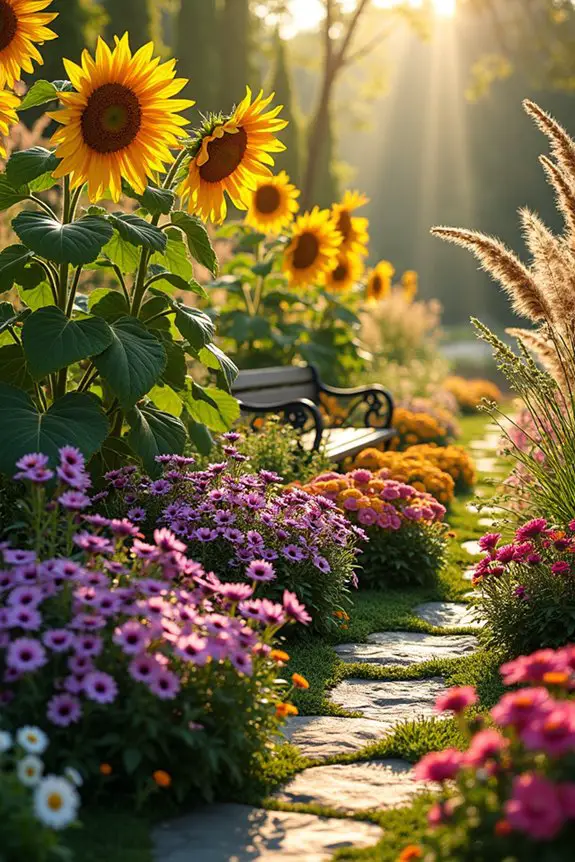
Creating a colorful flower bed can transform your garden into a vibrant masterpiece while also offering you a feast for the eyes. Not only do these beds add pops of color, but they also attract lovely pollinators like bees and butterflies, which brings a lively energy to your space. Who wouldn’t want their backyard buzzing with life? Imagine waking up to a burst of colors that feel like nature’s very own confetti party.
To kick things off, think about layering your plants. It’s not just for fashion anymore. By planting taller flowers like sunflowers or hollyhocks at the back (or center, if the bed is circular), and nesting smaller blooms like pansies or marigolds in front, you create depth. Not to mention, it keeps the shorter flowers from being overshadowed. A little side note: just like the first time I attempted layering clothes in winter, it may take a few tries to get it just right. But hang in there; your colorful masterpiece is a few soil turns away.
Next, consider color combination. Just like choosing the right frosting for your cake, flowers have hues that work wonders together. For instance, pairing yellows with purples creates a striking contrast—think of it like that fashion-forward duo that makes you do a double-take. Or stick with a monochromatic scheme, using different shades of pink or blue; it’s classy, gentle, and easy on the eyes, much like my knack for dressing in all black… and then spilling food on it.
And let’s not forget about texture. Mixing flowers with different leaf shapes and sizes adds an extra layer of interest. Maybe toss in some ornamental grasses alongside your zinnias and daisies. Imagine that delightful rustle when a breeze passes through, singing a sweet song that tugs at your heartstrings. You might even consider planting in biodegradable seed starter pots, as they support both your blooms and the environment.
While you’re at it, think about plant heights and blooming seasons—picture a well-coordinated dance number. Use a mix of annuals and perennials to guarantee there’s always something blooming, assuring eye candy throughout the seasons. You’ll feel a great sense of accomplishment with every bloom that unfurls, reminding you that patience pays off, just like that time I left my bread dough to rise… and forgot about it for a little too long.
Finally, don’t forget strategic placement. Think about visibility—ideally, you want your flower bed to be visible from your porch or a window. It’s like having a front-row seat to your own floral show. Plus, incorporating pathways or benches nearby encourages you to step outside and truly soak it all in, kind of like savoring the first bite of a freshly baked cookie.
Additionally, using fish emulsion fertilizer can help nourish your garden and promote healthy growth in your colorful flower beds.
In a nutshell, colorful flower bed arrangements are about inviting joy and vibrancy into your outdoor space. So, dig in, get dirty, and watch your garden bloom into its own little oasis of happiness. Happy planting!
3. Water Feature Integration
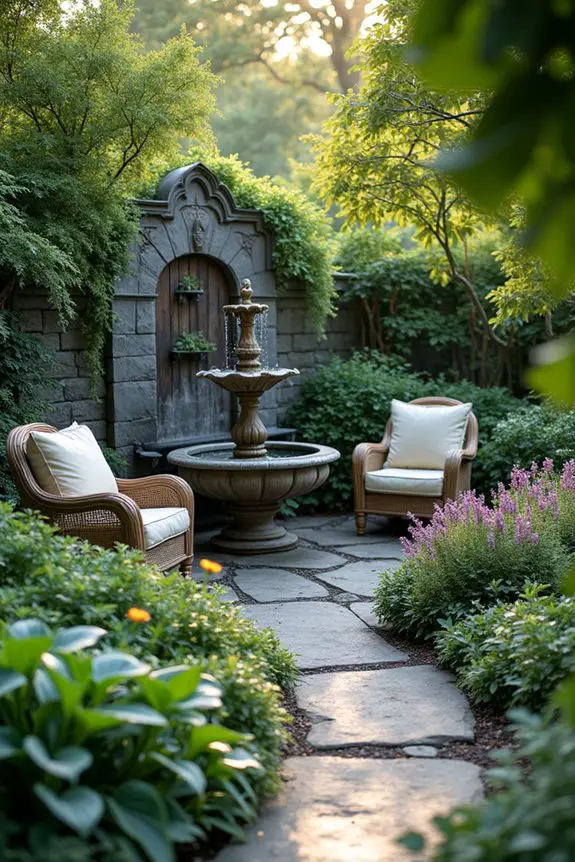
Integrating a water feature into your garden layout can create a serene atmosphere that enhances the overall vibe of the space. Envision listening to the gentle trickle of water while sipping your morning coffee, or watching the sun dance on the surface as it reflects a playful shimmer. This soothing addition not only serves as a calming focal point but also invites wildlife, adding to the lively ecosystem of your garden.
First off, think about the size and style of your water feature. Do you prefer a grand fountain that stands tall and proud, or a simple birdbath that offers a quick dip for our feathered friends? Bigger doesn’t always mean better; there’s charm in understated designs, too.
In one of my backyard adventures, I decided to install a small pond. Let’s just say that my “DIY” skills were put to the test, and I ended up with a mini marshland. Not exactly what I envisioned, but those frogs sure were happy.
Once you’ve chosen your feature, consider its location. Place it somewhere you’ll see it often, like near your patio or beside your favorite reading nook. That way, it’s not just for show—it becomes a part of your daily routine.
I once plopped a small fountain right next to my vegetable garden, only to realize every time I reached for a tomato, I’d get a revitalizing splash. Let’s just say my neighbors were entertained while I perfected my ‘not-so-graceful’ garden dance.
Next, think about the plants surrounding your water feature. They can soften the edges and blend everything beautifully. Opt for moisture-loving plants, like hostas or ferns, which enjoy the extra humidity. A garden water feature works wonders in creating that desired atmosphere. Furthermore, considering adding some solar spotlights motion sensor will enhance the beauty of your feature during the night.
I made the mistake of planting succulents next to my pond once, and let’s just say they weren’t thriving—much like my attempt at growing a “no-carb” garden that turned into a pizza heaven instead.
Finally, consider adding some lighting. That could mean installing solar lights or fairy lights to create a magical nighttime glow. Imagine this: you step outside in the evening to calm, twinkling lights reflecting off the water—the kind of dreamy setting that makes you feel like you’ve wandered into a storybook.
I once used string lights and accidentally created a mini disco vibe. Talk about an unexpected party in the garden, which was fun until I tripped over my own shoes while trying to dance.
4. Sustainable Plant Selection
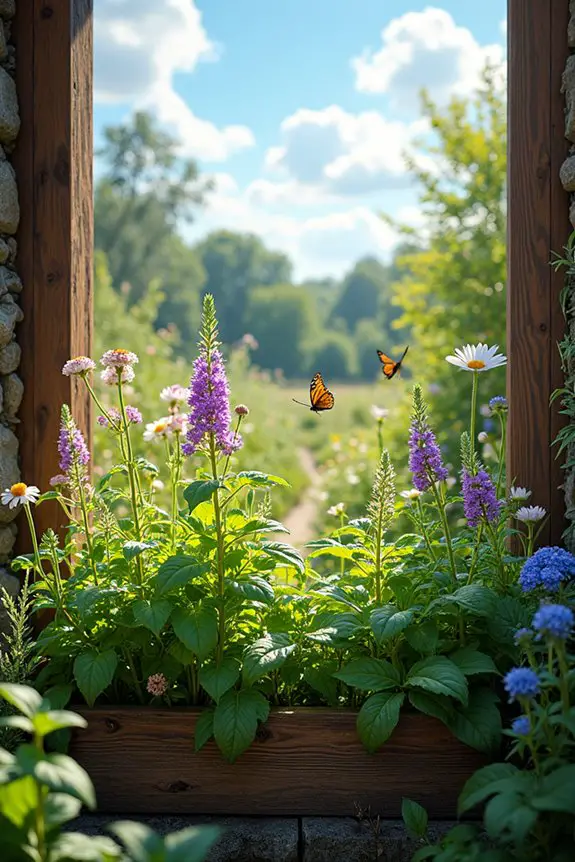
When designing your garden layout, choosing sustainable plants not only makes your space eco-friendly, but it also makes it more resilient and low-maintenance. Imagine walking through a garden filled with vibrant colors, unique textures, and the delightful buzz of happy pollinators. Sounds dreamy, right? Plus, plants that thrive naturally in your area are easier to care for, which leaves you more time to sip tea and enjoy the scenery.
First, think about native plants. These little gems are perfectly adapted to your local climate and soil, meaning less fuss for you. I once tried to introduce tropical plants into my temperate garden, thinking I could create a mini paradise. Spoiler alert: I ended up with wilted leaves and a very sad looking landscape. Instead, look for plants native to your region; they’ll flourish with minimal effort on your part. Consider wildflowers or indigenous grasses that invite butterflies and bees for a little garden party.
Next, opt for perennials over annuals. Sure, those bright annuals are tempting with their gorgeous blooms, but they require constant replanting and maintenance. Who’s time for that? I learned the hard way when a late frost knocked out my spring flower bed plans.
Perennials, on the other hand, come back year after year—like that friend who refuses to leave the party but brings snacks. Trust me, they’ve got your back. Plant them once, and they’ll cheer you on for seasons to come.
Don’t forget about companions. Companion planting can help reduce pests and improve plant growth. When I paired my tomatoes with basil, it was like the veggie version of a buddy cop movie—so much better together. Find out which plants benefit each other and group them for maximum garden harmony.
Just remember the garden mightn’t always be peaceful; sometimes, I catch my zucchinis arguing with the pumpkins over space. It’s tough being a plant.
Lastly, think about your garden’s watering needs. Selecting drought-resistant plants not only helps during hot months but also lowers your water bill. I learned this after setting up a complicated irrigation system that had a mind of its own—one minute I was watering; the next, I was dodging a water fountain gone rogue.
By choosing plants that thrive on less, you can save both water and sanity. Sustainable plant selection is about creating a space that feels alive and vibrant while being easy on yourself and the planet. Additionally, consider incorporating a window sill herb planter to enjoy fresh herbs while enhancing your sustainable garden efforts.
5. Vertical Garden Structures
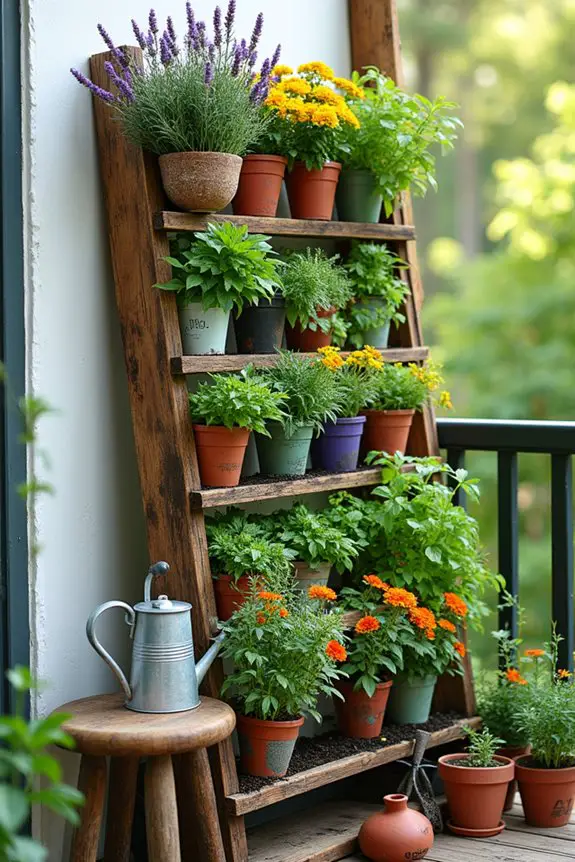
When your space is limited, vertical gardening can be a game changer. Imagine transforming a blank wall or a dull fence into a lush tapestry of greenery, all while keeping your garden cozy and stylish. It’s like adding a splash of color to a dull canvas; not only does it look great, but it also maximizes your growing potential. Who wouldn’t want a mini oasis without sacrificing square footage?
One popular option is a vertical garden frame, which can be crafted using simple materials like wood or metal. Picture it: a sturdy frame filled with pots or pockets bursting with herbs and flowers. You can hang it against a wall or even create a freestanding structure.
I once made a vertical herb garden that provided thyme, basil, and parsley right outside my kitchen. Trust me, there’s nothing like plucking fresh herbs while wearing an apron and pretending to be a gourmet chef. Spoiler alert: reality often involves burnt toast.
Another fun idea is using repurposed materials. Old pallets can be transformed into rustic vertical planters. Just lean a pallet against a wall, fill it with soil, and plant away.
I might’ve leaned my first attempt just a little too precariously, resulting in a mini avalanche of soil and plants. But hey, that just meant even more gardening fun. There’s something incredibly rewarding about crafting something beautiful out of what others might toss aside.
For those who love to rearrange, modular vertical planters are a great choice. These clever systems allow you to mix and match plants on different shelves or slots. Think of it as your wardrobe but for your garden.
You can swap out plants based on the season or just your current mood—feeling colorful? Go for bright flowers. In a calm mindset? Opt for soothing greens. Just like the time I impulsively painted my nails green during a calming phase, it felt great until I clashed with the kitchen decor.
Finally, don’t forget about drip irrigation systems. They can make keeping your vertical garden hydrated a breeze and save you from juggling watering cans like a circus performer.
I learned the hard way that the only thing worse than forgetting to water your plants is doing it while wearing a white shirt. Water everywhere but on the plants—classic. A simple drip system can help you ward off that delightful chaos.
Vertical gardens not only save space but also create a stunning visual impact that has you feeling zen. It’s all about finding creative ways to harness your garden’s potential while showing off a bit of your personality. So why not bring a little vertical flair to your garden today?
6. Seasonal Planting Schemes
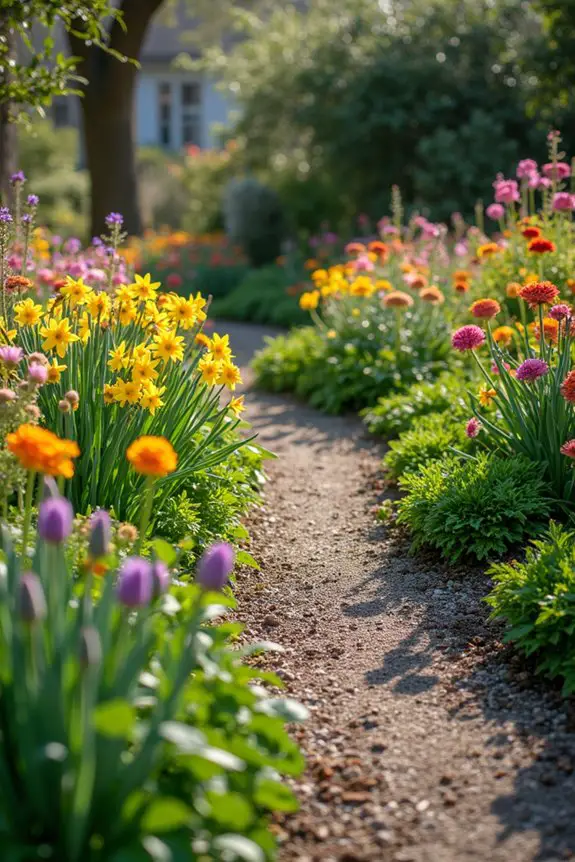
Creating a seasonal planting scheme is one of the best ways to keep your garden vibrant and fresh all year round. Think of it like preparing a savory dish where you add a pinch of this and a dash of that to create something truly scrumptious. Not only does this strategy keep your space looking alive, but it also allows you to enjoy a variety of blooms and edibles across the seasons.
So, how do you go about designing your seasonal planting layout? First, start by grouping plants according to their blooming or harvest cycle. For instance, in spring, think about planting cheerful tulips and daffodils alongside early herbs like chives and cilantro. You’ll get to experience that delightful burst of color just when winter tries to cling on.
Can’t you just picture yourself sipping lemonade while surrounded by a burst of color?
As summer rolls in, swap the spring blooms for vibrant sunflowers or zinnias. They’re not just striking; these beauties can thrive in sunny spots and attract helpful pollinators, boosting the overall health of your garden.
And let’s be honest—there’s something undeniably joyful about oversized sunflowers swaying in the breeze. Kind of like having your own cheering squad, but without the pom-poms.
The fall is the perfect time to incorporate rich golds and oranges from marigolds, while also planting hearty veggies cooler weather loves, like kale or carrots. It’s amazing how these colors deepen the warmth of your garden.
Plus, who doesn’t want to munch on home-grown carrots when they’re just a few steps from the back door? I once plucked a carrot that turned out to be the size of my forearm. You’ve never felt more like a gardener superhero.
Finally, don’t forget winter! Yes, plants are still your friends, even in the cold. Think of evergreens or winter-hardy flowers, like hellebores, to maintain that visual interest.
Imagine cozying up with a hot drink while gazing at your garden, even as snow gently dusts it. It brings a sense of magic, you know? Like a silent fairy tale.
As you sketch out your seasonal planting scheme, consider how each plant can complement the others regarding color and texture, incorporating a little mix-and-match magic.
Are they creating a cozy vibe? A festive atmosphere? It’s all about embracing those seasonal changes, turning your garden into a canvas that reflects the rhythm of nature.
Just remember, if the planting doesn’t work out perfectly the first time, it’s nothing that a little trial and error can’t fix—after all, that’s how we grow.
7. Functional Outdoor Seating Areas
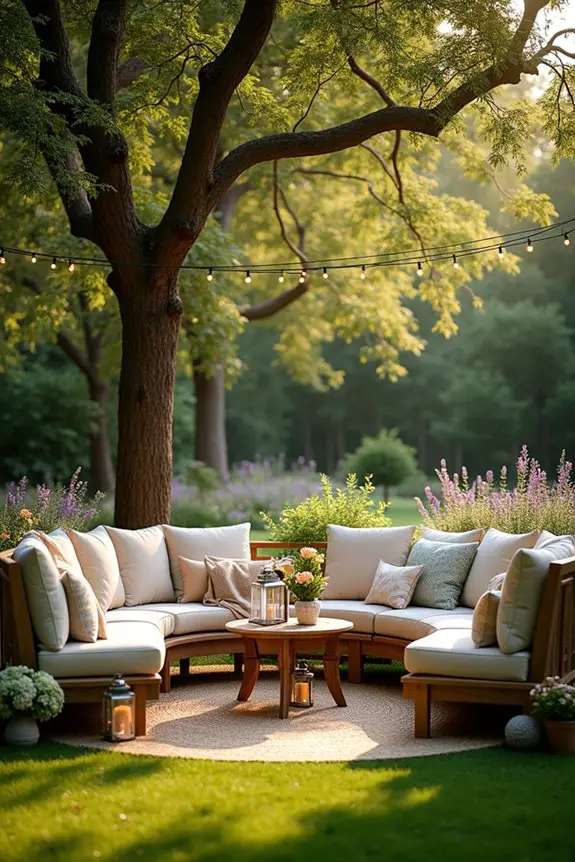
When it comes to outdoor seating areas, creating a cozy and functional space can transform your garden into a peaceful retreat. Think of it as assembling a delightful picnic spread—each element complements the other, making it a picnic you never want to end. With the right layout, not only do you gain practical seating for gatherings and relaxation, but you also set the mood for enjoying the beauty of nature.
Start by selecting a prime spot in your garden that receives a nice balance of sun and shade. This will guarantee you can enjoy your seating area all day long without turning into a sweaty mess. I once sat down in a patch of sun during the peak afternoon, and let’s just say, I won’t be making that mistake again anytime soon. Cozy nooks under trees or patios near flower beds create tranquil spots, making it a place you’ll look forward to spending time in.
Next, think about the type of seating. From classic benches to comfy chairs, choose something that suits your style and, more importantly, provides comfort—because who wants to sit on something hard while trying to sip their iced tea?
Arrange your seating in a way that fosters conversation. A rounded setup, kind of like a campfire circle, invites chatter and laughter. You know, the kind of setup where you can share stories about that time your carrot was the size of your forearm?
Don’t forget to layer in some soft touches—outdoor cushions, throws, or even a garden rug can make your outdoor oasis feel extra inviting. Imagine curling up with a good book on a soft cushion, surrounded by flowering plants and the gentle buzz of bees. Cozy, right?
Lighting adds an enchanting twist too. String lights or lanterns bring a warm glow to your evenings, letting you soak in the peaceful ambiance long after the sun goes down. Who doesn’t love a little fairy tale magic in their life?
Finally, adding a side table or two is essential for practicality. Whether it’s holding your frosty drink or your favorite garden journal, it creates a handy spot for all those little essentials. I once tried to balance my lemonade on my lap while flipping through a gardening book, and let’s just say, it was a recipe for disaster.
In the end, creating functional outdoor seating areas is all about crafting an experience—one that makes you smile, encourages relaxation, and invites friends and family to gather comfortably. It’s a canvas that allows you to express your personality and transform your garden into your personal haven.
8. Theme-Based Garden Zones
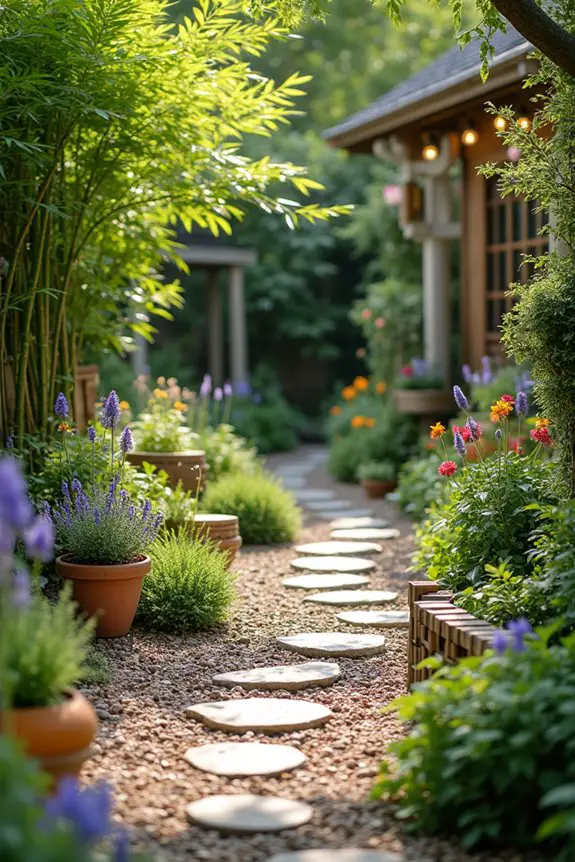
Creating theme-based garden zones is like setting different tables for a dinner party—each one has its personality and mood, making your overall garden feel lively and vibrant. Not only does this approach bring function to your space, but it also lets you explore different vibes within your garden, each zone telling its own little story.
First off, think about what themes resonate with you. Do you envision a tranquil zen area where you can meditate, or perhaps a lively herb garden for all your culinary experiments? I once attempted a medieval-inspired zone filled with wildflowers, and let’s just say it looked more like a friendly invasion of weeds than a castle garden. But hey, every great theme has its hiccups, right?
Once you’ve settled on a theme, layout becomes key. Start by marking out your zones with natural dividers—could be hedges, pathways, or even decorative rocks. In my herb garden, I used small wooden stakes to create a simple grid. It’s practical and gives a sense of order—because wandering aimlessly in chaos isn’t the vibe we want here.
Next, fill in your zones with plants that complement your theme. For that serene zen garden, think bamboo, rocks, and soft, flowing water features. For the herb garden, choose vibrant greens like basil, rosemary, and mint. Just remember, your plants also need love and attention—if you neglect them, well, they might just throw a wilting party that nobody wants to attend.
Consider adding seating or accessories that tie into each zone’s theme. A simple bench in your meditation area can invite quiet reflection, while colorful pots in your herb garden can bring a splash of fun. I once decorated a corner of my garden with quirky garden gnomes that, while they made me giggle, didn’t quite blend with the butterfly habitat I was going for.
Sometimes those playful touches can lead to unexpected charm.
Lastly, think about the path that connects these zones. Creating a winding trail encourages exploration and makes your garden feel like an adventure playground. Add a few stepping stones, or even a gravel path, and you’ll give guests the urge to meander and discover each unique area.
In the end, theme-based garden zones aren’t just about aesthetics—they cultivate different moods and feelings, letting you escape into various spaces all at once. Plus, they let your personality shine through, making your garden a true reflection of you. After all, who wouldn’t want a garden that feels like a little slice of paradise served up on a whim?
9. Mood Lighting Effects
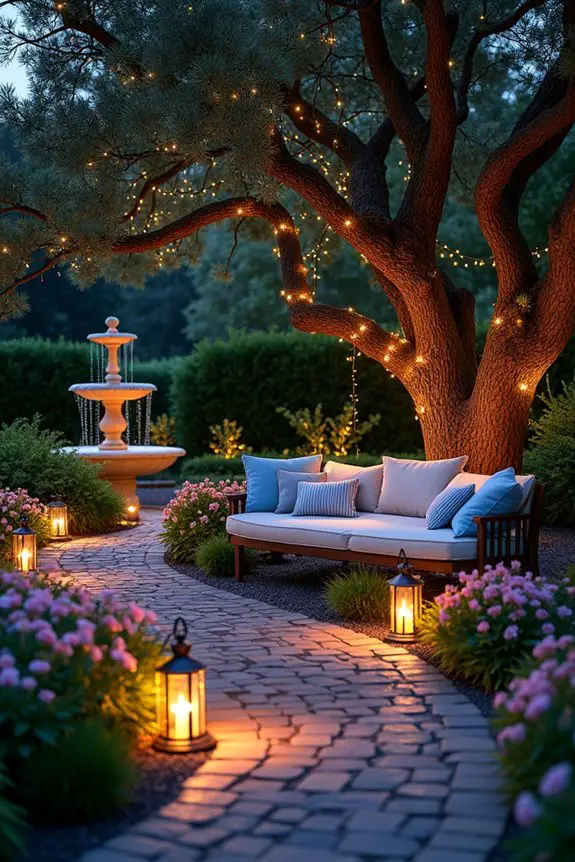
Mood lighting effects are like the secret sauce in a good recipe. They set the tone, create atmosphere, and can turn your garden from ordinary to extraordinary. Think about those cozy evenings spent outside with friends or that peaceful moment meditating while the moonlight dances around you. Proper lighting can make all the difference, giving your garden the calming vibe you crave after a long day.
First, consider the types of lights that suit your themes. Fairy lights wound in trees can transform a whimsical area into a magical hideaway, while lanterns set along pathways can guide your feet with a soft glow. I once sprinkled tiny solar lights throughout my flower beds—didn’t take long to realize I’d turned my garden into a landing strip for the local bug population. Lesson learned: overdoing it doesn’t always equate to charm.
Next, think about layering your lighting. Mix and match tall garden lights for height, low-lying lights to highlight ground-level plants, and candles for that romantic touch. Group them in clusters for a cozy nook or spread them out for a wider coverage.
On one particularly adventurous night, I decided to use a mix of candles and string lights, which was lovely—until a small breeze blew my candles out, and I’d an impromptu scavenger hunt in the dark. Don’t be me; planning is essential.
You might also experiment with color. Yes, colored bulbs can be a bit of a gamble, but when done right, they can enhance that desired mood. Soft blues can create a calming vibe, while warmer whites can bring a cheerful energy. Just don’t get too wild, or you might end up with a disco party vibe—which, I’ll admit, wasn’t what I was going for in my zen spot.
Placement is significant, too. Think about highlighting specific features like a beautiful tree, a sculpture, or a fountain. I once overlooked my garden statue and used mood lighting elsewhere, only to realize it looked like a sad little corner in the dark. A well-placed light can make even the simplest features pop, leaving your guests oohing and aahing.
Lastly, don’t forget about practical aspects. Confirm lights aren’t only aesthetically pleasing but safe, too. Route cords carefully and use weatherproof fixtures so you won’t find yourself in a lightless garden because of a sudden rainstorm. Trust me; the day I’d to fish out my leaky extension cord in muddy shoes is a memory I’d rather not revisit.
In the end, effective mood lighting creates magic in your garden, weaving a soothing tapestry of light that invites you in. It’s not just about seeing; it’s about feeling—welcoming those serene evenings under the starry sky while adding a dash of joy to your outdoor experience. After all, a well-lit garden is like a great recipe: it nourishes the soul and fills the heart with warmth.
10. Artistic Focal Point Creation
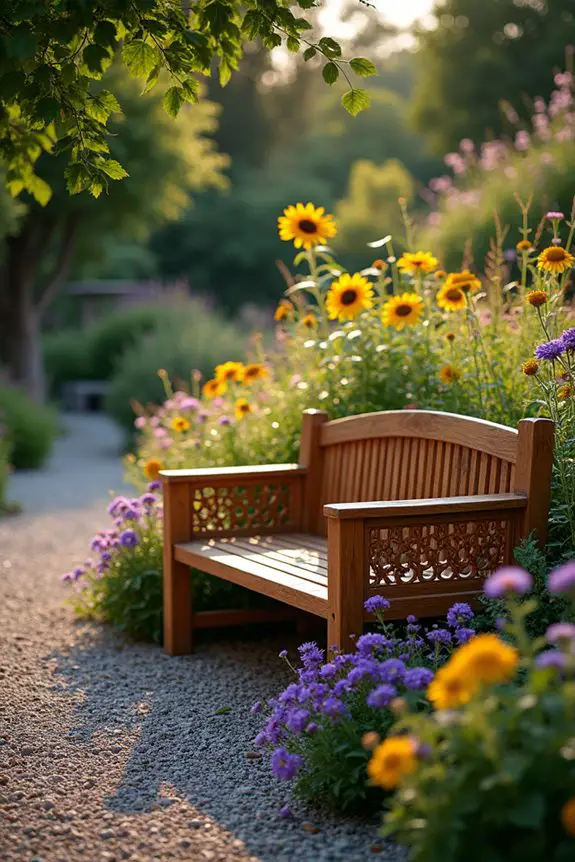
When designing your garden, consider creating an artistic focal point. This clever idea not only enhances functionality by drawing the eye but also elevates the overall vibe of your space. Think of it as putting the cherry on top of your gardening sundae; it makes everything feel complete and well thought out.
Start with a centerpiece that resonates with your style. Maybe it’s a stunning birdbath, a vibrant sculpture, or even a cozy seating area draped with colorful pillows. My neighbor recently transformed her bland patch of grass into a wonderland with a handcrafted wooden bench surrounded by wildflowers. It’s like she hit the jackpot of garden charm—and trust me, there’s nothing quite as satisfying as lounging in a space that feels intentionally curated.
Next, make certain your focal point is visible from multiple angles. If it’s hidden behind a bush, it might as well be invisible. Position it where it can catch your eye from the house or along your main pathways. I made the rookie mistake of placing my prized garden gnome where only the squirrels could see it. Let’s just say, no one was impressed by the gnome—a tragic oversight in my otherwise glorious garden plans.
Layer around this focal point with complementary elements. Use plants of varying heights, colors, and textures to guide the eye toward your chosen star. For instance, tall sunflowers can frame the sculpture while shorter marigolds can line the path leading to it. I once attempted a similar approach, but my towering sunflowers decided to lean at a wild angle, making it seem like they were giving a constantly awkward wink.
In the end, don’t shy away from a little personalization. Maybe you want to add a decorative path that leads your guests to this focal piece, or perhaps you set the scene with lighting that brings it to life at night. Remember the time I thought it would be nice to light my focal point with a string of fairy lights? It turned out to be a tangled mess that resembled an unruly octopus rather than the elegant glow I envisioned.
Lesson learned: simplicity can often shine brighter.
Expert Plant Care Advice
If you’ve ever wondered how to keep your plants from looking like sad little sticks, you’re in the right place. First things first: water them regularly—but don’t drown them.
Plants can be finicky, just like your mom after a long day. Next, consider your garden layout ideas design. Group plants with similar needs together. This saves you from constantly running around like a headless chicken, ensuring everyone’s getting what they need—light, water, and nutrients.
Don’t forget to prune those overgrown branches occasionally; think of it as giving your plants a much-needed haircut. And then, there’s compost.
You’ll be shocked at how much your plants appreciate a good meal. With a little love and attention, your garden can thrive instead of just surviving.

